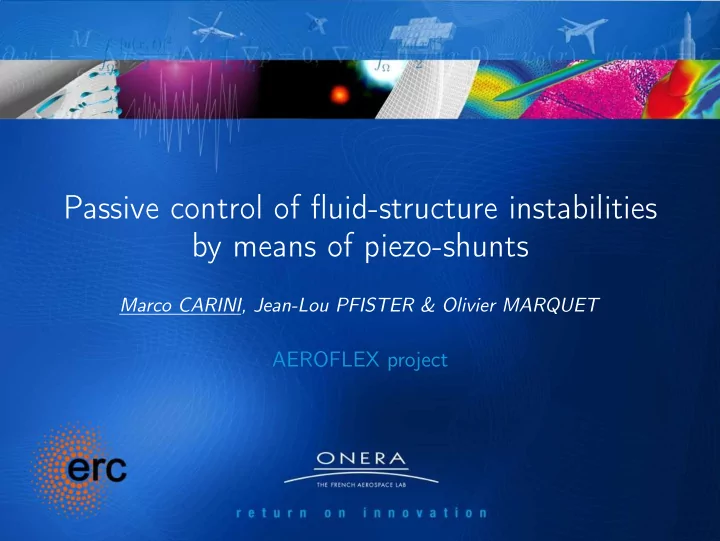

Passive control of fluid-structure instabilities by means of piezo-shunts Marco CARINI, Jean-Lou PFISTER & Olivier MARQUET AEROFLEX project
Piezo-electricity : a wide range of applications Piezo-electricity : Electric response of certain mate- rials to a mechanical stress due to their microscopic structure Sensing & Actuation from everyday life . . . . . . to the Aerospace Research Our Goal : using piezos to control fluid-structure instabilities Carini, Pfister & Marquet 2 / 12 31 January 2017
2D Model problem Fluid region Solid region Rigid cylinder + elastic plate + piezo patches. Re = U ∞ D/ν = 80 , density ratio m ρ = 50 and bending stiffness K = 0 . 3 . Electro-mechanical coupling only acting for bending modes ( transverse effect + opposite poiling direction ). Carini, Pfister & Marquet 3 / 12 31 January 2017
Modelling framework Arbitrary Lagrangian Eulerian approach Lagrangian for the solid. Eulerian description for the fluid. Eqs. in the underformed configuration Fully coupled nonlinear fluid-electro-mechanical system in compact form B ∂ q ∂t = R ( q ) . Linearization around a fixed equilibrium solution q B , i.e. R ( q B ) = 0 , with q ( x ) e λt q ( x , t ) = ˆ q = ∂ R ( q ) � � λ B ˆ q , ˆ � ∂ q � q B which is a Generalised Eigenvalue Problem , for λ = σ + ıω ∈ C : Carini, Pfister & Marquet 4 / 12 31 January 2017
Base flow & Leading ( unstable ) modes Base flow No Piezos Piezos Carini, Pfister & Marquet 5 / 12 31 January 2017
Global spectrum Without vs With Piezos 1.5 1.25 Added electrical stiffness effect ω 1 0.75 0.5 -0.25 -0.2 -0.15 -0.1 -0.05 0 0.05 σ Carini, Pfister & Marquet 6 / 12 31 January 2017
Connecting a R-shunt circuit 1st order electr. dynamics dQ e 1 + RC p Q e = 0 , dt τ e = RC p is the characteristic electrical time . Energy dissipation by Joule’s effect, P e = C p V 2 e /τ e . For τ e → 0 , electro-mechanical coupling becomes negligible (short-circuit). For τ e → ∞ , electro-mechanical coupling becomes maximal (open-circuit). Carini, Pfister & Marquet 7 / 12 31 January 2017
Varying the electrical resistance Leading eigenvalue 0.06 1.1 0.03 1 σ ω 0 0.9 −0.03 0.8 −0.06 0.7 −6 −4 −2 1 2 3 −6 −4 −2 1 2 3 log 10 τ e log 10 τ e Carini, Pfister & Marquet 8 / 12 31 January 2017
Varying the electrical resistance (continued) Increasing τ e 1.2 1 ω 0.8 0.6 -0.2 -0.15 -0.1 -0.05 0 0.05 σ Carini, Pfister & Marquet 9 / 12 31 January 2017
System energy analysis Leading mode × 10 −4 1.2 12 0.8 8 E s % P e % 0.4 4 0 0 −6 −4 −2 1 2 3 −6 −4 −2 1 2 3 log 10 τ e log 10 τ e Carini, Pfister & Marquet 10 / 12 31 January 2017
Conclusions A conjecture on two possible distinct stabilization mechanisms : Frequency desynchronization by means of the added electric stiffness ( original flutter mode ). Electrical damping through Joule effect ( new selected flutter mode ). Carini, Pfister & Marquet 11 / 12 31 January 2017
Thanks for your attention. (Any Questions ?)
Recommend
More recommend